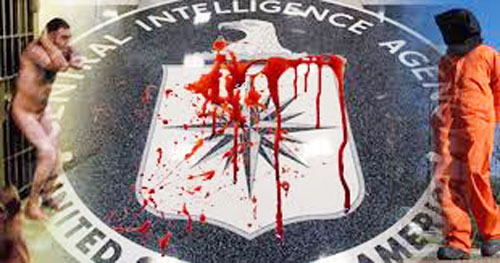The secret CIA torture program that has just come to light (2)
Read the first part of the article
“Special mission interrogations”

The CIA’s RDI program was also referred to at other times in various documents as the Rendition Group (RG), the Rendition and Detention Group (RDG), or more simply as Special Mission interrogation, as the operation was run under the authority of the Special Mission Division (SMD) of the CIA’s Counterterrorism Center (CTC).
SMD special missions are likely constructed as Special Access Programs, with levels of secrecy that exceed Top Secret/Sensitive Compartmented Information levels of security. Knowledge of such programs are compartmented on a strict need-to-know basis, and are typically unacknowledged. Revealing such a program can land you in jail.
Special access programs are authorized by Executive Order 13526, “Classified National Security Information”. On the other hand, the non-RDI CIA detention and interrogation program authorization was derived from the September 17, 2001 Memorandum of Notification (MON) signed by President Bush.
The MON specifically authorized CIA to direct “operations designed to capture and detain persons who pose a continuing, serious threat of violence or death to U.S. persons and interests or who are planning terrorist activities.” It did not, one can see, authorize the construction of a new set of interrogation techniques, or to run a torture program.
As an example of how such secrecy works, by spring 2003, after a bureaucratic struggle between OMS and OTS over the staffing and operations of the RDI program, most of the OTS contractors (including apparently Mitchell and his partner, John Bruce Jessen) had been transferred from OTS to the RDI group at CTC. From that point forward, even “OTS managers were not to be briefed on the compartmented portions of the program,” according to the head of OMS.
No doubt much of the CIA’s aggravation over the release of a portion of the Senate Intelligence Committee’s review of their torture and detention activities is because the RDI program is named at various points in the report’s Executive Summary, which was released in redacted form to the public.
Previous references to RDI or OTC in relation to the torture program – as in the release of the CIA’s 2004 Inspector General Report on detention and interrogation activities – were very few and had no context about what they really meant to the CIA program.
Still, the references to RDI in the Senate report were mostly relegated to footnotes, and also provided no context. Nowhere in the released report is there an explanation that the RDI program was separate in any way, or that it was run from a different department from the rest of the interrogation and detention program. There is no mention of the CIA’s Special Mission Division. In the end, the Senate report obfuscated the separation between the RDI and the CTC programs.
The RDI program held dozens of so-called High-Value Targets or detainees over the course of its existence. It received, by the account of its own chief medical official, “extraordinary guidance and oversight”. Its overt mission was to gather imminent information of terrorist attacks on the United States. Its other goal appears to have been human subject or prisoner research on the effects of the CIA’s “enhanced interrogation” set of techniques.
Surprisingly, some of the pressure to conduct experiments on the effectiveness of the individual techniques like waterboarding came from top CIA officials and Bush administration officials, including the CIA’s own Inspector General, as well as members of Congress. At that point, both OMS and Mitchell and Jessen argued against such effectiveness experiments, claiming that such data could not be quantified.
Interrogation, or we might say torture, is not a science, but a (dark) art, Mitchell and Jessen argued to their superiors.
The “CTC Program” and “Standard” Techniques of Interrogation
The CIA’s other torture program was known by differing names: Counterterrorism Detention and Interrogation Activities (CDIA) or Program, the “CTC Program,” or, as the Senate Select Committee on Intelligence called it, simply, the CIA Detention and Interrogation Program. That program did not have OMS oversight (until after a detainee died in its custody), nor did it have ongoing authority to use “enhanced interrogation” techniques (though they may have used some of them).
According to the CIA’s Chief at OMS, the non-RDI program had “no written interrogation guidelines… nor was OMS advised of interrogations… Interrogators… [were] left to their own devices, sometimes improvised”.
The CIA black sites under CTC supervision were not well supervised initially. These prisons were generally not holding high-value detainees, but prisoners deemed of some intelligence use from the wars in Iraq and Afghanistan. The black sites run under this program included the notorious Salt Pit prison in Afghanistan, and most likely a CIA black site within Abu Ghraib prison.
While the RDI program required medical check-ups before and after interrogation, and full psychological assessments on prisoners, the CDIA program required none of that. When a medical issue arose, a physician’s assistant on temporary duty was sent to the black site to attend to the problem. At the RDI sites, doctors were always in attendance.
The CDIA program utilized so-called “standard” CIA interrogation techniques. According to the CIA’s OMS chief, these included those “deemed not to incorporate significant physical or psychological pressure”.
This CIA program supposedly did not include “enhanced interrogation techniques, but early on was granted permission to employ sleep deprivation, solitary confinement, noise, and eventually standing sleep deprivation, nakedness and cold showers. As these were not ‘enhanced’ techniques, no medical monitoring function was specified…”.
The “standard” techniques did include, however, sleep deprivation (at first up to 72 hours, but later no more than 48 hours), diapering (not to exceed 72 hours), reduced caloric intake (aka partial starvation, but supposedly adequate to maintain general health), isolation, loud music or white noise, and denial of reading material.
It is unclear where CIA derived the authorization to use these so-called standard techniques. Their use may derive the February 7, 2002 decision by the Bush Administration that Taliban and Al Qaeda prisoners were not covered by Geneva Convention protections. Or they may stem from an alleged secret executive order by President Bush that allowed use of “stress positions”, sleep “management”, loud music and “sensory deprivation through the use of hoods, etc.,” reported in a May 2004 FBI email.
The CDIA interrogators reportedly improvised techniques at these black sites, including blowing smoke in detainees’ faces, “physically aggressive ‘hard takedowns’ and staged ‘executions’.”
According to the Chief, OMS, “The only death tied directly to the detainee program took place in this context at” the Salt Pit prison. That black site was not part of the RDI/OTS program.
After the death of the detainee, Gul Rahman, RDI was given responsibility for the site, while OMS took over “psychologist coverage” there. In addition, from that point onward “prior approval” was needed for use of such “standard” techniques as described above, “whenever feasible”.
“Truth Drugs”

The ACLU’s release of the OMS document had a big play in the news because a portion of it discussed the possibility, supposedly discarded, of using the tranquilizer Versed as a “truth drug” on CIA detainees held in the RDI program. But CIA reticence to request legal clearance to use drugs – a clearance actually granted with caveats in John Yoo’s famous August 2002 torture memo – was in part due to fears it would spawn charges regarding the “prohibition on medical experiments on prisoners”.
If CIA was not conducting such medical experiments, why was it afraid it would be charged with doing so? OMS officials seem to have been keenly aware at how close their operations were to breaking federal laws on illegal experimentation on prisoners. They also were worried about a longtime ban on the interrogational use of “mind-altering” drugs which “profoundly altered the senses”.
The OMS document refers to an article by George Bimmerle (a pseudonym) on “truth drugs”. In the 1950s, Bimmerle worked for the Behavioral Activities Branch (BAB) at CIA’s Technical Services Division, the forerunner to OTS. It was BAB staff that helped assemble with the notorious CIA KUBARK manual, which as far back as 1963 advocated, with reservations, the use of various torture techniques, including use of drugs.
According to the OMS history, “In 1977 the Agency introduced the text of Bimmerle’s article, without title, author, date or sourcing into Congressional Hearings on MKULTRA, as a statement of then current thinking on drugs in interrogation. LSD received only the passing comment that ‘information obtained from a person in a psychotic drug state would be unrealistic, bizarre, and extremely difficult to assess… Conceivably, on the other hand, an adversary service could use such drugs to produce anxiety or terror in medically unsophisticated subjects unable to distinguish drug-induced psychosis from actual insanity’.”
OMS may have been reluctant to use “truth drugs”, but its Chief found that drugs labeled as such can sometimes cause “some amnesia” which he found constituted “a sometimes desirable secondary effect”. Induction of amnesia was a goal of some of the MKULTRA experiments conducted in the 1950s-1970s, according to a number of accounts, including this one in Smithsonian Magazine.
OMS’s Chief was cagey when discussing the possible use of drugs in his personal memoir. He (or she) noted that when a Congressional committee asked the CIA why they didn’t use drugs on prisoners, an Agency official responded. “The answer was that drugs don’t work – which is true, probably.” Probably?
But more likely OMS reluctance regarding use of drugs would raise questions about illegal experiments, and the RDI program was already vulnerable to such charges given its use of medical monitoring and adjustment for “techniques” like waterboarding via use of devices that monitor oxygen levels, or because of aspects of the experimental program that have not yet been revealed.
The use of drugs, so explosive when revealed in the scandals around MKULTRA, could be a trigger to investigations. Some in the Agency could perhaps recall the days when the New York Times ran headlines like “Abuses in Testing of Drugs by C.I.A.”, and when use of drugs by the CIA was a focus of Congressional investigations.
All in all, the controversies around CIA use of “truth drugs” deserve greater examination.
We do know that the CIA certainly used drugs that were not standard truth drugs to facilitate “enhanced interrogations”, a fact also ignored in mainstream media accounts about CIA’s torture operations.
For instance, OMS doctors administered blood thinning drugs to prolong detainees’ ability to physically tolerate stress positions used in standing sleep deprivation without seriously causing damage from tissue edema. They may also have administered antimalarial and other drugs because of the disorienting and incapacitating effects these drugs can sometimes produce.
Meanwhile, the Chief of OMS wrote that OMS “scrupulously avoided involuntarily medicating detainees” in the RDI program. But that doesn’t mean that OTS interrogators did not utilize drugs, or that drugs were administered outside the RDI program.
Besides the musings about “truth drugs”, another revelation in the release of the OMS Chief’s memoir concerned ongoing collaboration between the U.S. federal Bureau of Prisons (BOP) and the CIA on the operations of the latter’s secret black site detention program.
According to the OMS account, the CIA saw their collaboration with BOP as a possible defense for any CIA/OMS doctors or psychologists brought up on ethics charges at state licensing boards. If a licensing board moved against any CIA medical personnel, “Bureau of Prisons policy and medical personnel would be similarly implicated”.
Read the third part of the article
yogaesoteric
February 1, 2019
